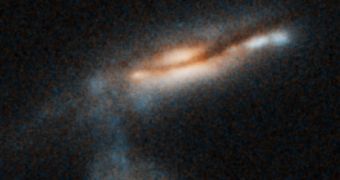The universe originated in a Big Bang event more than 13 billion years ago, no doubt about that. However, much of its previous history and complexity misses key elements, which are necessary in order to create an accurate theory of the universe's evolution. As space telescopes get better, they enable us to view even further back in space, thus in time, due to the fact the light does not travel instantaneously through space, enabling us to view galaxies in the early stages of formation, quasars hundreds of times brighter than a whole galaxy and even stars that burn gas at unbelievable low temperatures.
For example, new discoveries reported at the American Astronomical Society argue that only two billion years after the Big Bang the galaxies present in the universe were interacting with a frequency four times higher than they are doing today, due to inflation. Currently, it is estimated that about 10 percent of the galaxies observed in the visible universe are engaged in gravitational interactions and even merge.
Infrared observations of the early universe could reveal new stars hiding inside massive clouds of matter, galaxies and quasars. Why infrared? you might ask. Well, as the universe expands, the light traveling from distant objects suffers the actions of the Doppler effect which shifts the frequency of the optical light towards the red end of the spectrum. For example, the Microwave Background Radiation, used to make the image of matter distribution in the early universe, was actually light in the visible spectrum emitted by the first stars that populated it.
Further advantages of the use of infrared light also include the fact that it can penetrate through massive clouds of gas and dust, a crucial aspect when one is trying to imagine an object through a massive structure such as a galactic core, for example.
Anyway, infrared scans of the sky revealed what seems to be a low mass star, with a surface temperature of only 100 degrees Celsius, the kind we now call a brown dwarf. The star, designated ULAS J 0034, presents an absolute temperature of only twice that of our planet.
According to Stephen Warren from the Imperial College London, the observations in the infrared wavelengths will reveal millions of galaxies in less than 4 years from now. A similar program uses X-ray light to study mysterious quasars, thought to dominate the sky. The Sloan Digital Sky Survey presented that extremely bright quasars powered by massive black holes that may represent as much as half of the total population of quasars thought to exist in the universe.
However, much still remains to be discovered. For example, most of the observations currently made involve massive bright objects, such as stars and quasars. But the universe was not always so abundant in stars and large objects. There is little information about the previous state of the matter, the so called gas component of the universe. Yet, more than 75 percent of the total mass of the universe is believed to be composed of molecular gas and dust, or even dark matter invisible in the optical spectrum. After all, it is the gas what makes a star, not the other way around.

 14 DAY TRIAL //
14 DAY TRIAL //